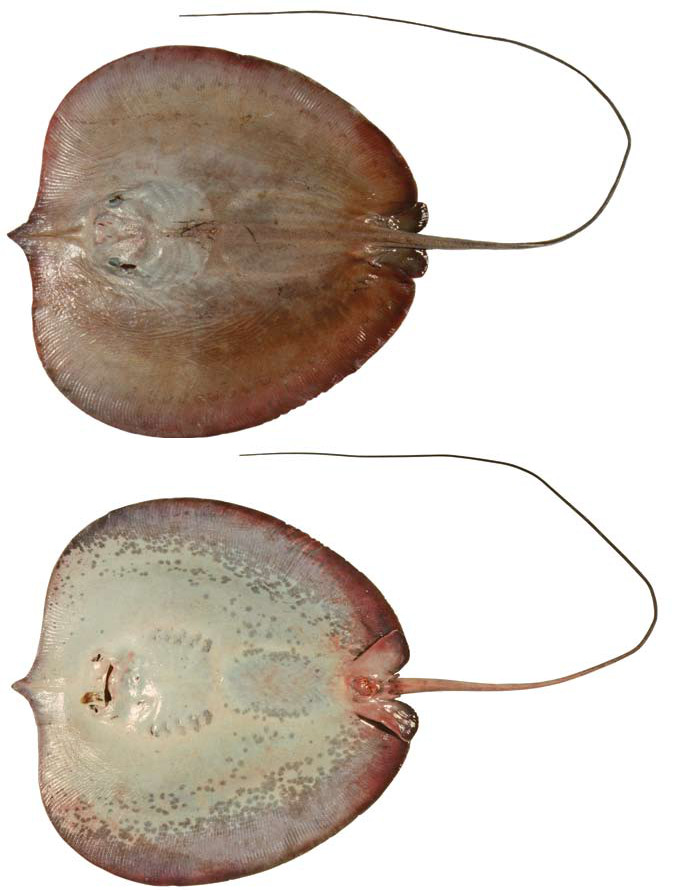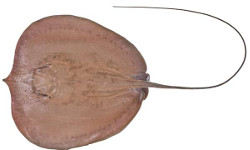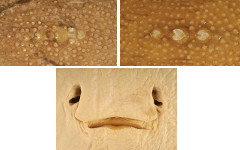Urogymnus dalyensis
(Last & Manjaji-Matsumoto, 2008)
Classification: Elasmobranchii Myliobatiformes Dasyatidae
Reference of the original description
Himantura dalyensis sp. nov., a new estuarine whipray (Myliobatoidei: Dasyatidae) from northern Australia. CSIRO Marine and Atmospheric Research Paper, 22, 283–292
Himantura dalyensis sp. nov., a new estuarine whipray (Myliobatoidei: Dasyatidae) from northern Australia. CSIRO Marine and Atmospheric Research Paper, 22, 283–292
Image of the original description

Urogymnus dalyensis (Last & Manjaji-Matsumoto, 2008), juvenile male holotype (CSIRO H 2503–01, 620 mm DW, fresh): dorsal view; ventral view. In: Last, P.R. & Manjaji-Matsumoto, B.M. (2008): Himantura dalyensis sp. nov, a new estuarine whipray (Myliobatoidei: Dasyatidae) from northern Australia. CSIRO Marine and Atmospheric Research Paper, 22: 283-292

Urogymnus dalyensis (Last & Manjaji-Matsumoto, 2008), juvenile male holotype (CSIRO H 2503–01, 620 mm DW, fresh): dorsal view; ventral view. In: Last, P.R. & Manjaji-Matsumoto, B.M. (2008): Himantura dalyensis sp. nov, a new estuarine whipray (Myliobatoidei: Dasyatidae) from northern Australia. CSIRO Marine and Atmospheric Research Paper, 22: 283-292
Synonyms / new combinations and misspellings
Himantura dalyensis
Himantura dalyensis
Types
Urogymnus dalyensis
Himantura dalyensis
Holotype: CSIRO: H 2503-01; Paratype: CSIRO: H 2524-01; CSIRO: H 6657-01; FUMT: P 10863; NTM: S 16248-001; NTM: S 15184-001; NTM: S 15183-001; NTM: S 14745-001; WAM: P.32955-001;
Urogymnus dalyensis
Himantura dalyensis
Holotype: CSIRO: H 2503-01; Paratype: CSIRO: H 2524-01; CSIRO: H 6657-01; FUMT: P 10863; NTM: S 16248-001; NTM: S 15184-001; NTM: S 15183-001; NTM: S 14745-001; WAM: P.32955-001;
Description :
Citation: Urogymnus dalyensis (Last & Manjaji-Matsumoto, 2008): In: Database of modern sharks, rays and chimaeras, www.shark-references.com, World Wide Web electronic publication, Version 12/2025
Please send your images of "Urogymnus dalyensis" to info@shark-references.com

Urogymnus dalyensis (Last & Manjaji-Matsumoto, 2008) © Peter M. Kyne, Charles Darwin University, Australia

Urogymnus dalyensis (Last & Manjaji-Matsumoto, 2008) © Peter M. Kyne, Charles Darwin University, Australia
Common names
 Freshwater whipray
Freshwater whipray
 Freshwater whipray
Freshwater whipray
Short Description
Original diagnosis by LAST & MANJAJI-MATSUMOTO, 2008 [3353]: A species of Himantura distinguished by a combination of the following features: disc subcircular, snout tip to axis of maximum width 41–44% DW; anterior disc margin truncated, almost transverse; preorbital snout obtuse, angle 120–121°, with a distinct apical lobe; preorbit long, length 27–28% DW, 2.1–2.2 times interorbital length; internasal distance 1.9–2.1 in prenasal length, 3.2–3.6 times nostril length; preoral snout length 3.3–3.4 times mouth width, 2.4–2.6 times internarial distance; lateral apices broadly rounded; orbits very small, protruded slightly; denticles along mid-trunk relatively sparse, band without well-defined margin, mid-scapular denticle small or inconspicuous; tertiary denticles present; disc uniformly pale brown or greyish brown dorsally; ventrally, disc whitish with broad, dark marginal bands, their inner margins irregular and bordered with dark blotches; marginal bands slightly broader posteriorly, their maximum width subequal to mouth width; pelvic-fin tips dark on ventral surface; tail dark brown to blackish dorsally, whitish ventrally forward of sting base, almost uniformly black beyond sting; propterygial radials 73–78, 2.7–2.9 times the number of mesopterygial radials; total vertebral segments 120–121.
Original diagnosis by LAST & MANJAJI-MATSUMOTO, 2008 [3353]: A species of Himantura distinguished by a combination of the following features: disc subcircular, snout tip to axis of maximum width 41–44% DW; anterior disc margin truncated, almost transverse; preorbital snout obtuse, angle 120–121°, with a distinct apical lobe; preorbit long, length 27–28% DW, 2.1–2.2 times interorbital length; internasal distance 1.9–2.1 in prenasal length, 3.2–3.6 times nostril length; preoral snout length 3.3–3.4 times mouth width, 2.4–2.6 times internarial distance; lateral apices broadly rounded; orbits very small, protruded slightly; denticles along mid-trunk relatively sparse, band without well-defined margin, mid-scapular denticle small or inconspicuous; tertiary denticles present; disc uniformly pale brown or greyish brown dorsally; ventrally, disc whitish with broad, dark marginal bands, their inner margins irregular and bordered with dark blotches; marginal bands slightly broader posteriorly, their maximum width subequal to mouth width; pelvic-fin tips dark on ventral surface; tail dark brown to blackish dorsally, whitish ventrally forward of sting base, almost uniformly black beyond sting; propterygial radials 73–78, 2.7–2.9 times the number of mesopterygial radials; total vertebral segments 120–121.
Dentition
Teeth small, broadly suboval to rhomboidal, in quincunx; subequal in size in upper and lower jaws; with prominent horizontal ridge and groove. Tooth rows in upper jaw of paratype CSIRO H 6657–01 about 37, in lower jaw about 45. [3353]
Teeth small, broadly suboval to rhomboidal, in quincunx; subequal in size in upper and lower jaws; with prominent horizontal ridge and groove. Tooth rows in upper jaw of paratype CSIRO H 6657–01 about 37, in lower jaw about 45. [3353]
Remarks
shark-references Species-ID=14660;
shark-references Species-ID=14660;


















